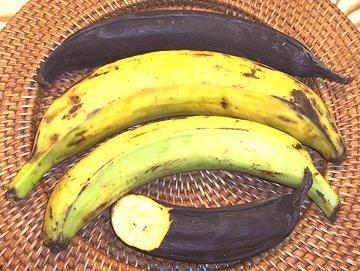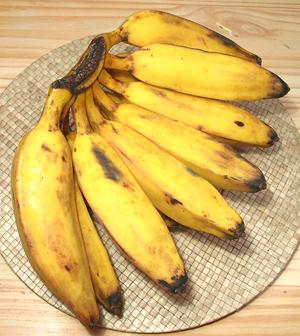 [#4236, Cooking Banana; Macho Banana (Markets); Dodo (West Africa);
Musa acuminata x balbisiana (AAB and ABB groups), formerly
Musa paradisiaca]
[#4236, Cooking Banana; Macho Banana (Markets); Dodo (West Africa);
Musa acuminata x balbisiana (AAB and ABB groups), formerly
Musa paradisiaca]
This is a culinary classification of bananas, and not a specific scientific definition. This name is applied to bananas that are starchier and less sweet than "dessert" bananas like Cavendish. Plantains are most often cooked while still green or somewhat green, but are also cooked when yellow, depending on taste and texture desired. They are still quite firm when solid yellow and can still be fried in that state. Some recipes call for them ripe, when they will be solid black and finally have softened. The flesh tends to be a little orange in color. The average plantain sold in North America is about 12 inches long and weighs about 9-3/4 ounces.
More on Bananas.
 [Saba Banana, Carababa Banana, Philippine Plantain; Musa acuminata x
balbisiana (ABB group)]
[Saba Banana, Carababa Banana, Philippine Plantain; Musa acuminata x
balbisiana (ABB group)]
These are much smaller than the more common plantains and rather boxy in shape. The photo specimens were between 6 and 6-1/2 inches long (not counting stem) and weighed about 6-1/4 ounces. A 6-1/4 ounce specimen yielded 3 ounces peeled (48%). In the yellow state shown they were rather firm, starchy and not particularly sweet. This plantain is used widely for sweets and savories.
Large South American plantains are now grown in the southern
Philippines but have not caught on yet because their size makes them
awkward for the most common uses, and because many people are unaware
they become sweet enough for their other uses when solid black.
Plantains are starchier, firmer and less sweet than dessert bananas so they are most often cooked rather than eaten raw out of hand. Personally I rather like them just peeled, because I like my fruit snacks a bit less sweet than many do. In southern India the peels are diced small and used in some recipes, but I haven't yet found what kind of recipes.
bn_plantz 101030 - www.clovegarden.com
©Andrew Grygus - agryg@clovegarden.com - Photos on this
page not otherwise credited are © cg1 -
Linking to and non-commercial use of this page permitted